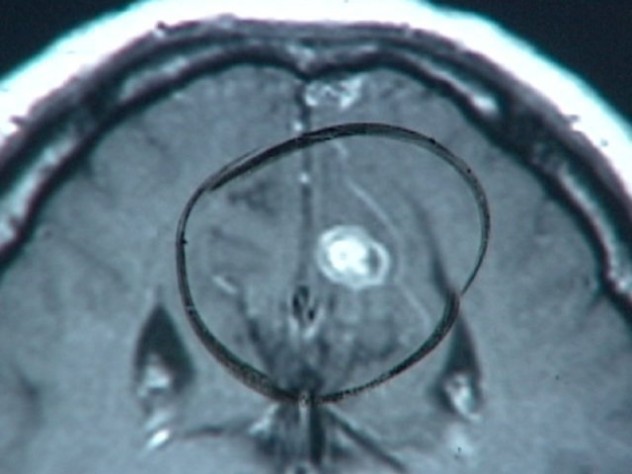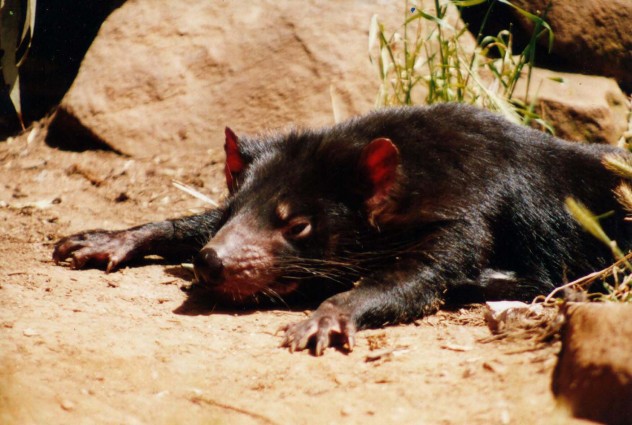 Weird Stuff
Weird Stuff  Weird Stuff
Weird Stuff  Our World
Our World 10 Ways Your Christmas Tree Is More Lit Than You Think
 Movies and TV
Movies and TV The 10 Coolest Stars to Set Sail on The Love Boat
 History
History 10 Things You Didn’t Know About the American National Anthem
 Technology
Technology Top 10 Everyday Tech Buzzwords That Hide a Darker Past
 Humans
Humans 10 Everyday Human Behaviors That Are Actually Survival Instincts
 Animals
Animals 10 Animals That Humiliated and Harmed Historical Leaders
 History
History 10 Most Influential Protests in Modern History
 Creepy
Creepy 10 More Representations of Death from Myth, Legend, and Folktale
 Technology
Technology 10 Scientific Breakthroughs of 2025 That’ll Change Everything
 Weird Stuff
Weird Stuff Ten Bizarre Facts About The Doge Meme
 Our World
Our World 10 Ways Your Christmas Tree Is More Lit Than You Think
 Movies and TV
Movies and TV The 10 Coolest Stars to Set Sail on The Love Boat
Who's Behind Listverse?

Jamie Frater
Head Editor
Jamie founded Listverse due to an insatiable desire to share fascinating, obscure, and bizarre facts. He has been a guest speaker on numerous national radio and television stations and is a five time published author.
More About Us History
History 10 Things You Didn’t Know About the American National Anthem
 Technology
Technology Top 10 Everyday Tech Buzzwords That Hide a Darker Past
 Humans
Humans 10 Everyday Human Behaviors That Are Actually Survival Instincts
 Animals
Animals 10 Animals That Humiliated and Harmed Historical Leaders
 History
History 10 Most Influential Protests in Modern History
 Creepy
Creepy 10 More Representations of Death from Myth, Legend, and Folktale
 Technology
Technology 10 Scientific Breakthroughs of 2025 That’ll Change Everything
10 Fascinating Facts About Cancer
Cancer is an incredibly variable set of diseases, a reckless malignant growth of cells which, despite intense amounts of research, remains poorly understood. Dozens of factors have been tied to increasing the risk of cancer, including genetics, obesity, exposure to radiation, smoking, and alcohol abuse. Still more factors are said to help prevent the disease, such as exercise, drinking coffee, and eating a diet rich in fruits and vegetables. Many medical studies are misleading and agenda-driven, and any hope for an effective cure is so far into the future as to be unimaginable.
10 The Unwilling Pedophile

We know well that even the most subtle distortion to our brains can change every aspect of our being. Brain cancer (tumors growing inside the skull) can cause a vast array of different effects depending on their size and location. Tumors growing near the pituitary gland can provoke unchecked growth, while those in the frontal lobes can cause memory loss, depression, and even fits of violence. While these effects can vary dramatically, most are well documented, but that is not to say even the sophisticated medical community is not occasionally thrown for a loop.
One patient described by neurologists Russell Swerdlow and Jeffrey Burns of the University of Virginia was a married 40-year-old man of otherwise normal predilections who suddenly became obsessed with sex—particularly with pedophilia. He began using the Internet to look up child porn and consorted with prostitutes. Worse yet, he was a schoolteacher. After the man’s wife discovered his sinister activities, she was understandably horrified and threw him out of the house. He was convicted of child molestation and forced into a 12-step Sexaholics program in lieu of jail time. Unfortunately, he tried to hit on the female group members and was kicked out. Right before he would have been remanded to prison, he checked into a hospital with a headache and an uncontrollable urge to rape his landlady. Shortly thereafter, he received an MRI that revealed a tumor about the size of an egg growing in the right lobe of his orbifrontal cortex.
The tumor was removed, his horrible urges went away, and he returned home. Yet seven months later, he began to relapse into his old behavior. Another scan revealed that the tumor had come back. It was removed once again, and again he returned to his normal self. The implications of this case are obviously chilling: Even the best among us has only tenuous control of his own psyche.
9 Tasmanian Devils

Like humans, many animals suffer from cancer. A particularly gruesome and deadly form is devil facial tumor disease (DTFD) which is quickly wiping out the Tasmanian devil. First discovered in 1996, the cancer is spread when the devils bite each other fighting over food and mating privileges. Tumors appear on the head and face, then travel throughout the body. The devil’s immune system does not recognize the cancer as a foreign agent and does nothing to fight it; the disease is 100 percent fatal. Scientists believe that if no cure is found, the Tasmanian devil will be effectively extinct by 2035. Their population has fallen by 70 percent since 1996. Researchers are working frantically to save the devil. Warner Brothers, whose hugely popular Tasmanian devil character has earned millions, contributes royalties to help the cause.
Other animals display a marked resistance or even immunity to cancer. Sharks rarely get cancer, and the disease has never been found in the bizarre naked mole rat, a Listverse favorite.
8Dwarfism

There are many forms of dwarfism. One of the most rare was first reported in 1966 in the South American nation of Ecuador. Called Laron Syndrome, it is an extremely unique affliction. While dwarfism is usually caused by a lack of growth hormones, Laron patients have normal levels. However, they possess a genetic mutation that causes their bodies to fail to respond to the hormones.
While living as a dwarf in a world of average-sized people certainly has its disadvantages, Laron syndrome comes with an extraordinary benefit: It seems that the same cellular mechanism that keeps the dwarfs small also protects them from age-related disease. A study of 99 people with the syndrome heralded no incidence of diabetes and only a single case of cancer. Researchers like Robert Salvatori of Johns Hopkins University in Baltimore are studying small people for clues on how to help others prolong their lifespans. He asserts that a drug or diet should one day be available that would lower growth hormone levels and lessen disease. Salvatori also cautioned that if low growth hormone insulates the body against cancer, then the opposite should also be true, and people like professional athletes who take megadoses would be putting themselves at extreme risk for developing malignancies later in life.
7 Triangle Of Death

Whenever the term “triangle” is used to refer to a place, it tends to result in a lot of tragedy, and Italy’s Triangle Of Death is no different. Located in the province of Campania, the points of the triangle constitute the towns of Acerra, Nola, and Marigliano. This area is perhaps not coincidentally the stomping grounds of the Camorra—Campania’s answer to the Mafia. One of the Camorra’s many rackets has been waste management, disposing of the toxic byproducts created by Italy’s industrial companies for a fraction of what it would cost to have it professionally removed. The sludge is variously dumped down wells, buried in shallow holes where it leeches into the soil, stored in warehouses, and poured into rivers. There are literally thousands of illegal dumps scattered throughout the countryside.
The fallout of this sinister business is devastating. Those who live within the triangle are ravaged by cancer, with more than double the rate of liver cancer than those living in the rest of Italy, and hugely elevated levels in all other types, including leukemia. Young people seem particularly affected, with people in their 20s and 30s manifesting the types of cancers usually suffered by senior citizens in other parts of the world. Other healthy issues are present as well, including birth defects. A study of telomere DNA sequences on women of the area conducted by the University of Naples has even discovered that the prevalence of chemicals is causing premature aging.
6Teratomas

Cancer by its very definition is horrifying, but some versions come straight out of nightmares. Teratomas or dermoid cysts, which are thought to be congenital (present at birth), come from cancer of the female egg. Although it is unfertilized, the cancer causes it to grow certain human characteristics. Though typically benign, these growths can be gruesome. Teratomas have been discovered with hair, teeth, nails, and sweat glands growing inside.
Even more bizarre growths have been found featuring eyes, limbs, and even malformed fetus-like structures. In 2008, a doctor at Memorial Hospital for Children in Colorado Springs, Colorado made a horrifying discovery after an MRI showed an abnormality in a newborn’s brain. Surgery revealed the growth inside, believed to have been a tumor, featured a tiny foot, and the beginning of another foot, a thigh, and a hand.
5Flash Photography

In the years before digital photography, red eye was the bane of amateur photographers. Photo albums from your childhood are probably full of shots of you with your eyes glowing like a demon (red eye is more pronounced in kids). The effect is due to the light from the flash of the camera passing through the eye and then reflecting back. The red color comes from blood. Strangely enough, one of the signs of a childhood cancer called retinoblastoma is when one eye in a photograph presents as red and the other is normal. Even more common is leukocoria, when one eye is red and the other appears white. This is due to an aggressive tumor growing within the eye which blocks the light and does not allow it to reflect normally. While there are many available treatments, often complete enucleation (removal of the eye) is required.
4Susan G. Komen For The Cure

Susan G. Komen for the Cure is the largest breast cancer organization in the United States, probably best known for its pink ribbon logo. Although the charity has done a lot of good, they have also generated a great deal of controversy. One of the schemes they utilize is called “pinkwashing,” allowing sponsors (such as Yoplait, Ford, and American Express) to use their logo as a marketing tool in return for donations.
They have also made several ill-advised moves for suspected political reasons. In 2012, they halted their funding for Planned Parenthood mammograms. Although the organization cited an ongoing congressional investigation, it was apparent to many that the funding was cut because Planned Parenthood also performs abortions. There was a massive public backlash, with private donors, including New York City Mayor Michael Bloomberg, donating hundreds of thousands of dollars to make up for the shortfall. In a similar pro-life vein, Komen has withdrawn millions in funding from hospitals like Johns Hopkins University School of Medicine and the University of Kansas Medical Center, which have been performing embryonic stem cell research. Staunchly pro-life Karen Handel, the Komen Vice President for Public Policy spoke out against embryonic stem cell research, but said she was in support of adult stem cell research.
They have also been criticized for how they spend their donation money. For instance, the CEO of Komen, Nancy Brinker, makes $684,000 a year, an exorbitant salary given the revenue of the organization.
3Warren Zevon

Warren Zevon was a rock-and roll-genius with a penchant for macabre lyrics. He has collaborated with a great many artists over the course of his career, including The Everly Brothers, Jackson Browne, and Mick Fleetwood. His most famous song is likely “Werewolves of London.” He has frequently appeared on the Late Show with David Letterman as a stand-in for bandleader Paul Shaffer.
In 2002, Zevon was diagnosed with peritoneal mesothelioma, a cancer of the abdomen related to asbestos. The condition was inoperable, and Zevon refused chemotherapy, believing it would make him too sick to realize his dream of recording one final album. He indeed finished The Wind, which featured friends like Bruce Springsteen and Tom Petty. When his prognosis of terminal cancer was made public, he would tell reporters that he only hoped to live long enough to see the next James Bond film, Die Another Day which was released in November 2002. Warren Zevon not only got to enjoy the movie, but triumphed over his cancer long enough to see his twin grandsons born the following June and the release of The Wind on August 26. Less than two weeks later, he was gone.
2E-Cigarettes

Although the idea for electronic cigarettes has been around at least since the early 1960s, their popularity exploded in 2012. Countries throughout the world are still wrestling with the implications of the device: whether to class it as a tobacco or medicinal product, whether it should be legal to utilize it indoors, or whether minors should be able to purchase it. In the US, laws vary wildly from state to state. Most e-cigarette manufacturers market their product not as a stepping stone to quitting like nicotine gum or patches, but rather as an alternative to traditional cigarettes.
E-cigarettes work by using a heating element to vaporize a fluid that contains nicotine. Users espouse the health benefits, but a recent study published in France’s National Consumer Institute magazine makes the claim that some e-cigarettes have comparable levels of carcinogens to regular cigarettes, containing such delightful cancer-causing ingredients as formaldehyde and acrolein. However, larger, more long-term studies will be needed to determine exactly how dangerous e-cigarettes are and how close a link to cancer they truly have.
1Michael Douglas

Michael Douglas is a veteran actor probably best known for his role as Gordon Gekko in Wall Street. In August 2010, the unfortunate news broke that Douglas had been diagnosed with stage IV throat cancer. He initially attributed the affliction to hard living and years of drinking and smoking. His eldest son had just been sentenced to federal prison for selling crystal meth, and the actor was plagued with stress. Despite the grim prognosis, chemotherapy and radiation treatments sent him into remission . . . and then he sat down to do an interview with reporter Xan Brooks from the UK newspaper The Guardian.
During the interview, he touched upon various topics, but when the subject of his illness was broached, he said that “without wanting to get too specific, this particular cancer is caused by HPV [human papillomavirus] which actually comes about from cunnilingus.” He went on to explain to the stunned reporter that oral sex is actually the best cure for his form of throat cancer as well. After the interview went into print, Douglas tried to backtrack through his spokesman, Allen Burry, saying that he was misunderstood—but his wording was rather concise.
To be fair, Douglas’s statement was partially correct. The sexually transmitted disease HPV, which may manifest as genital warts or may be completely asymptomatic, can cause cancer in the cervix, anus, penis, vulva, and vagina. When there is oral-genital contact, it can cause cancer of the neck. The US Centers for Disease Control and Prevention states that approximately 60 percent of oropharyngeal cancer—that of the throat, tonsils, and tongue—are caused by HPV. Just under 12,000 cases of HPV-related neck cancer are reported annually. Unfortunately, HPV can be very difficult to test for, but vaccines have recently been developed for both women and men.
However, no studies currently support his claim that oral sex can cure cancer.
Mike Devlin is an aspiring novelist.








